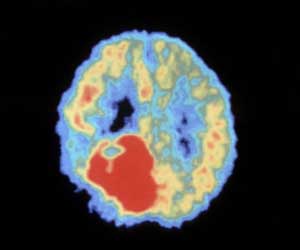A checkpoint protein that allows certain brain tumor cells to avoid the immune system has been characterized by a new scientific study.

TOP INSIGHT
A checkpoint protein that allows certain brain tumor cells to avoid the immune system has been characterized by a new scientific study.
"The researchers investigated Cdk5 because it is commonly expressed in abundance and high Cdk5 levels correlate with a worse clinical prognosis in patients with melanoma, brain, breast, and lung cancers," explained Alex Huang, associate professor of pediatrics, pathology, and biomedical engineering at the School of Medicine, and co-senior author of the study. Agnes Petrosiute, assistant professor of pediatrics at the School of Medicine, was the other senior author. Both are also pediatric oncologists at the Angie Fowler Adolescent & Young Adult Cancer Institute at University Hospitals Rainbow Babies & Children's Hospital.
When the researchers blocked Cdk5 inside tumor cells and injected them into mice, more than half of the mice survived. Nearly all of the mice injected with tumor cells still containing Cdk5 died. This suggested to the researchers that Cdk5 plays a central role in regulating the mice immune system response to tumors. By systematically depleting subsets of white blood cells in the mice, the researchers were able to identify CD4+ T cells as the primary immune cells responsible for removing the Cdk5-deficient tumor cells and sparing the mice from tumors.
Human T cells with CD4+ molecules on their surfaces communicate in part via an immune system signaling molecule called interferon. Many tumor cells disrupt this communication mechanism by expressing a molecule on their own surfaces called programmed cell death-ligand 1 (PD-L1). The PD-L1 protein is also found on immune cells and normally helps "turn down" the immune system to avoid collateral damage once an immune response is complete. Tumor cells with PD-L1 on their surfaces can similarly deactivate T cells in their microenvironment and evade the immune system.
The researchers discovered that PD-L1 expression on tumor cells correlated with Cdk5 expression. They tested several types of tumor cells without Cdk5 and found them unable to robustly produce PD-L1 on their surfaces in response to immune signaling molecules. Without Cdk5 or PD-L1, the tumor cells were much more vulnerable to the immune system. The researchers confirmed this by disrupting the PD-L1 gene in tumor cells directly. Tumor cells without PD-L1 were unable to develop into lethal tumors in the majority of mice. These findings clearly show a central role for Cdk5 in modulating a tumor's ability to produce PD-L1.
The central role for Cdk5 in driving PD-L1 expression appears to be highly specific. Other proteins that act in response to immune signaling molecules were not affected by the lack of Cdk5 in tumor cells.
Approximately one-third of tumors can be combated by blocking PD-L1. This study shows that blocking Cdk5 may be another way to block PD-L1 on the surfaces of tumors and recruit CD4+ immune cells to shrink tumors. The researchers have characterized this pathway in medulloblastoma tumors, but preliminary evidence suggests it may also be applicable for other types of cancers.
Medulloblastoma accounts for approximately one-fifth of all pediatric brain tumors, suggests the American Brain Tumor Association. The vast majority of diagnoses occur in children under age 10 and surgery is the primary treatment mechanism.
Source-Eurekalert
 MEDINDIA
MEDINDIA




 Email
Email










